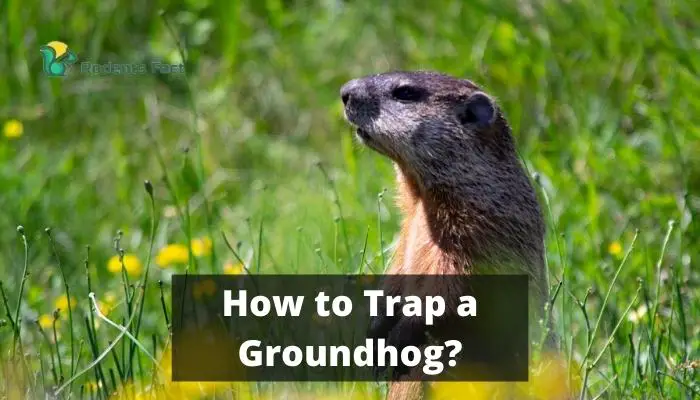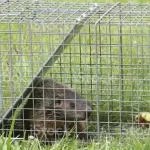Proven Method on How to Trap a Groundhog?
The groundhog, also known as a woodchuck, is a rodent of the family Sciuridae. Groundhogs are found in North America and build burrows to live and store food.
While they may look cute, groundhogs can cause a great deal of destruction to your garden or farmland. If you think you have a groundhog problem, You must eliminate it. So, how to trap a groundhog?

These burrows can cause severe damage to yards, gardens, and crops.
Trapping a groundhog is one of the most effective ways to remove it from your property. You will also need to bait the trap with something that will attract the groundhog. Peanut butter or sweetcorn are good options. Once the trap is set, you can trap the groundhog.
How to Trap a Woodchuck: Tested Method
You might be confused about how to catch a woodchuck. You don’t need to worry about this problem. You will need to follow these steps to trap a woodchuck:

Choose the Sort of Trap to Employ
There are two types of traps best for trapping groundhogs. One is a live trap and another one is a snap trap. Many professionals recommend choosing the live trap because these traps are bigger and can be placed outside.
Traps with a design range of 32 inches to 42 inches for groundhogs in your garden are ideal. In the early spring, set the trap.
Look for a Groundhog Hole
You have to look for the woodchuck hole. So that you can deploy your trap. First, you have to clean the trap and then fix the trap according to the manual. You have to make sure the trap is perfectly working. Because sometimes the traps don’t work. You have to test the trap by yourself.
Also, you have to hide it carefully. Because of that, the groundhogs won’t see the trap. And also you have to lure it by giving some bait.
Initially, Set the Trap Remained Open

You have to set the trap open. And you have given the groundhogs some bait (vegetable, fruit) to lure them into the trap. After setting it up, you have to inspect the trap often. By that, you can be sure about the trap.
When Your Groundhog Is Captured, Cover Your Trap With a Fabric Sheet
After you see the groundhog is captured, you have to act gently. Don’t make the woodchuck frightened. If you make him nervous, the woodchuck can bite you. So you have to act very gently and cover the trap with a fabric sheet. And you have to move the groundhog to a new place where he can live easily.

Set the Groundhog Free
After reaching out to the new location, you have to set him free. Because you don’t have to kill him, they are kind of rear animals. So we have to take care of them. You can set free the groundhog at the riverside.
Choose a trap that is large enough to hold the groundhog. A live trap is a good option because it will allow you to release the groundhog elsewhere.
Bait the trap with something the groundhog will find irresistible, such as fresh fruits or vegetables. Place the trap in an area where the groundhog is active. You may need to set it up several times before you finally catch the groundhog.
Check the trap regularly and remove any animals that have been caught. Be sure to relocate the groundhog at least five miles away from your property to prevent it from coming back.
If you want to tarp chipmunks, you can read our guide on how to make a chipmunk trap too.
What Kind of Trap Can I Use to Trap Groundhogs?
There are a few different traps that you can use to catch groundhogs.

One option is to use a snap trap. These traps are small and can be placed strategically around the yard. You will need to bait the trap with something the groundhogs will eat, such as a piece of meat or a portion of fruit. Once the groundhogs are in the trap, you can release the catch pole and grab the trap.
Another option is a live trap. These traps are more extensive and can be set in open areas. To begin with, pick a live trap big enough to accommodate a groundhog. Live traps for single and double doors should be at least 10x10x24 and 10x10x30 inches, respectively.
What’s the best bait to trap groundhogs easily? Let’s have a look!
Are Live Traps Effective to Get Rid of Groundhogs?
Another way to reduce the number of groundhogs on your property is using a live trap. The most popular traps for catching these rodents are foothold traps. However, some regional and municipal regulations forbid these strategies when catching groundhogs.

Live traps are thus not favored today, and their efficacy is likewise constrained. You may need to relocate the trap many times every week. Due to the need to set up traps in multiple areas, this strategy also requires a lot of time.
The following video shows how to catch a groundhog by using a live trap:
What Is the Best Way to Catch Groundhogs?
Create a bait trail with cantaloupe leading to the trap for best results. If you can identify your groundhog’s burrow, place some bait at the entrance, and then position your baited trap about 3 feet from the hole.

Avoid transferring your scent to the trap by wearing gloves when baiting and setting the trap. If you’re unsure where the groundhog’s burrow is, try setting the trap in a likely spot, such as along a fence line or near a pile of fresh dirt.
Additional link: “Why do Capybaras Hang Out with Other Animals?”
Which Size Trap for Groundhogs?
There are many types of groundhog traps, but the trap size is the most crucial factor to consider. The size, design, and number of doors of woodchuck traps vary, but the application is where the most differences may be found.

Lethal traps are intended to kill or harm the prisoner, whereas living traps are meant to keep the animal alive. Live traps for single and double doors should be at least 10x10x24 and 10x10x30 inches, respectively.
What Is the Best Time of Day to Trap a Groundhog?
Being diurnal animals, groundhogs are most active in the morning and late in the day. In the evening, disengage a set trap to avoid trapping an undesirable animal.
Groundhogs are wary of people and will avoid a trap if it smells like a person. Suppose you want to catch a groundhog. They can become aggressive.
Frequently Asked Question
How to Catch a Groundhog Without a Trap?
There is no need to trap a groundhog when you want to catch one, as long as you have a sturdy stick or cane. Lure the groundhog out of its burrow with a piece of food, and then just wait until it comes out. When it does, jab the stick or cane into its back, and it will be yours!
Is it illegal to catch and release groundhogs?
It is generally illegal to catch and release groundhogs in most states. This is because groundhogs are considered wild animals, and as such, they are protected by law. It is also illegal to release wild animals into the wild, which is why it is generally frowned upon with groundhogs.
How hard is it to trap a groundhog?
You might be confused about how easy it is to catch a groundhog. Trapping groundhogs don’t have to be complicated. There are a few different options that work pretty well.
Final Words
Knowing how to trap a groundhog may be helpful if you’re experiencing destruction to your garden or farmland.
Groundhogs are hard to catch. According to numerous references, groundhogs carry their underground burrows with them and burrow up to 5 feet deep anywhere they settle in. Trapping groundhogs is nearly impossible.
Your best bet at catching a groundhog is to lure it out with a strawberry or piece of cheese. If it’s a male, a groundhog that eats will be more apt to stay above ground and more likely to investigate the trap.




